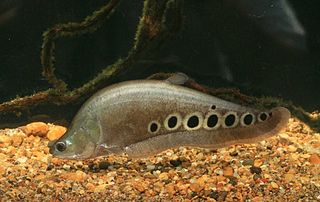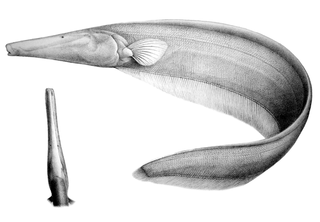
The Gymnotiformes are an order of teleost bony fishes commonly known as Neotropical knifefish or South American knifefish. They have long bodies and swim using undulations of their elongated anal fin. Found almost exclusively in fresh water, these mostly nocturnal fish are capable of producing electric fields to detect prey, for navigation, communication, and, in the case of the electric eel, attack and defense. A few species are familiar to the aquarium trade, such as the black ghost knifefish, the glass knifefish, and the banded knifefish.

Electrophorus electricus is the best-known species of electric eel. It is a South American electric fish. Until the discovery of two additional species in 2019, the genus was classified as the monotypic, with this species the only one in the genus. Despite the name, it is not an eel, but rather a knifefish. It is considered as a freshwater teleost which contains an electrogenic tissue that produces electric discharges.

The ghost knifefishes are a family, Apteronotidae, of ray-finned fishes in the order Gymnotiformes. These fish are native to Panama and South America. They inhabit a wide range of freshwater habitats, but more than half the species in the family are found deep in rivers where there is little or no light.

An electric fish is any fish that can generate electric fields. Most electric fish are also electroreceptive, meaning that they can sense electric fields. The only exception is the stargazer family (Uranoscopidae). Electric fish, although a small minority of all fishes, include both oceanic and freshwater species, and both cartilaginous and bony fishes.

The black ghost knifefish is a tropical fish belonging to the ghost knifefish family (Apteronotidae). They originate in freshwater habitats in South America where they range from Venezuela to the Paraguay–Paraná River, including the Amazon Basin. They are popular in aquaria. The fish is all black except for two white rings on its tail, and a white blaze on its nose, which can occasionally extend into a stripe down its back. It moves mainly by undulating a long fin on its underside. It will grow to a length of 18"-20". Only a fish for those with large aquariums, minimum 100 gallons.

Electroreception and electrogenesis are the closely related biological abilities to perceive electrical stimuli and to generate electric fields. Both are used to locate prey; stronger electric discharges are used in a few groups of fishes to stun prey. The capabilities are found almost exclusively in aquatic or amphibious animals, since water is a much better conductor of electricity than air. In passive electrolocation, objects such as prey are detected by sensing the electric fields they create. In active electrolocation, fish generate a weak electric field and sense the different distortions of that field created by objects that conduct or resist electricity. Active electrolocation is practised by two groups of weakly electric fish, the Gymnotiformes (knifefishes) and the Mormyridae (elephantfishes), and by Gymnarchus niloticus, the African knifefish. An electric fish generates an electric field using an electric organ, modified from muscles in its tail. The field is called weak if it is only enough to detect prey, and strong if it is powerful enough to stun or kill. The field may be in brief pulses, as in the elephantfishes, or a continuous wave, as in the knifefishes. Some strongly electric fish, such as the electric eel, locate prey by generating a weak electric field, and then discharge their electric organs strongly to stun the prey; other strongly electric fish, such as the electric ray, electrolocate passively. The stargazers are unique in being strongly electric but not using electrolocation.
Biological immortality is a state in which the rate of mortality from senescence is stable or decreasing, thus decoupling it from chronological age. Various unicellular and multicellular species, including some vertebrates, achieve this state either throughout their existence or after living long enough. A biologically immortal living being can still die from means other than senescence, such as through injury, poison, disease, predation, lack of available resources, or changes to environment.
Following is a list of topics related to life extension:

Gymnarchus niloticus – commonly known as the aba, aba aba, frankfish, freshwater rat-tail, poisson-cheval, or African knifefish – is an electric fish, and the only species in the genus Gymnarchus and the family Gymnarchidae within the order Osteoglossiformes. It is found in swamps, lakes and rivers in the Nile, Turkana, Chad, Niger, Volta, Senegal, and Gambia basins.

The clown featherback, also known as the clown knifefish and spotted knifefish, is a nocturnal species of tropical fish with a long, knife-like body. This knifefish is native to freshwater habitats in Cambodia, China, Hong Kong, Laos, Macau, Taiwan, Thailand, and Vietnam, but it has also been introduced to regions outside its native range. It is one of the world's most invasive species.
Apteronotus galvisi is a species of ghost knifefish that was first described in a 2007 scientific paper. It is endemic to Colombia. It has a mostly brown body, with some areas of yellow or white.

Orthosternarchus tamandua, the tamandua knifefish, is a species of weakly electric knifefish in the family Apteronotidae, native to the deep river channels of the Amazon basin. This species is characterized by its whitish-pink color, long tubular snout, long dorsal appendage, and tiny, bilaterally asymmetrical eyes.

Negligible senescence is a term coined by biogerontologist Caleb Finch to denote organisms that do not exhibit evidence of biological aging (senescence), such as measurable reductions in their reproductive capability, measurable functional decline, or rising death rates with age. There are many species where scientists have seen no increase in mortality after maturity. This may mean that the lifespan of the organism is so long that researchers' subjects have not yet lived up to the time when a measure of the species' longevity can be made. Turtles, for example, were once thought to lack senescence, but more extensive observations have found evidence of decreasing fitness with age.

Tembeassu marauna is a species of weakly electric knifefish in the family Apteronotidae and the only member of its genus, known only from three specimens collected from the upper Paraná River, Brazil, in 1965. This fish can be identified by fleshy extensions at the tips of its upper and lower jaws, with the upper extension bearing a patch of extra teeth. The function of these unique structures is unknown, but may relate to feeding. Apparently a specialized inhabitant of deep riverine environments, T. marauna may be endangered by extensive dam construction in the upper Paraná region, if not already extinct.

Apteronotus is a genus of weakly electric knifefish in the family Apteronotidae, distinguished by the presence of a tiny tail fin. This genus is restricted to tropical and subtropical South America and Panama where found in a wide range of freshwater habitats. They feed on small animals.

The jamming avoidance response is a behavior of some species of weakly electric fish. It occurs when two electric fish with wave discharges meet – if their discharge frequencies are very similar, each fish shifts its discharge frequency to increase the difference between the two. By doing this, both fish prevent jamming of their sense of electroreception.

Günther K.H. Zupanc (born 20 October 1958) is a German-American neurobiologist, researcher, university teacher, book author, journal editor, and educational reformer. He is a Professor in the Department of Biology at Northeastern University in Boston, Massachusetts.
Sternarchella, the bulldog knifefish, is a genus of ghost knifefishes found at depths of 2–50 m (7–164 ft) in the main channel of large rivers in South America. Most are from the Amazon basin, but S. orthos is found both in the Amazon and Orinoco, S. orinoco is restricted to the Orinoco and S. curvioperculata restricted to the upper Paraná basin. They are often common in their habitat.
Compsaraia samueli, the pelican knifefish, is a species of apteronotid electric fish from the western Amazon basin of Brazil and Peru. It exhibits pronounced sexual dimorphism in which mature males develop extremely elongated snouts and oral jaws. This phenotype is found in several other apteronotid species and is used in agonistic jaw-locking behaviors between males.
Apteronotus rostratus is a species of apteronotid electric fish. These fish typically exhibit a wide diversity of skull shapes, ranging from highly elongate skulls to highly foreshortened ones, with both types evolving independently multiple times. In Apteronotus rostratus and some others, such as Compsaraia samueli, mature males grow extremely elongated snouts and oral jaws which are used in agonistic interactions with other males. This is an example of sexual weaponry. A study comparing skull shape and jaw-closing performance in males and females of Apteronotus rostratus suggested that males with elongated faces for use in fights did not have lower mechanical advantages, in contrast to the similar species Compsaraia samueli in which males exhibit a trade-off between sexual weaponry and jaw leverage.










